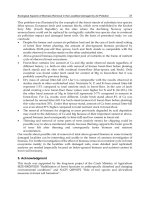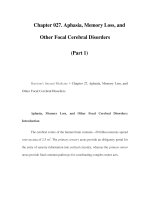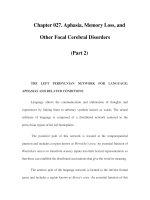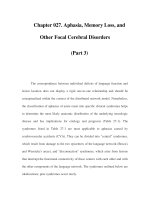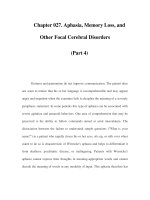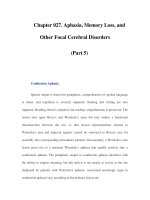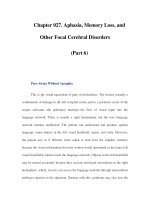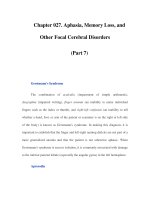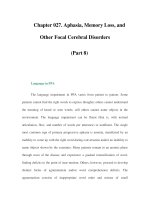Chapter 027. Aphasia, Memory Loss, and Other Focal Cerebral Disorders (Part 3) pot
Bạn đang xem bản rút gọn của tài liệu. Xem và tải ngay bản đầy đủ của tài liệu tại đây (12.43 KB, 5 trang )
Chapter 027. Aphasia, Memory Loss, and
Other Focal Cerebral Disorders
(Part 3)
The correspondence between individual deficits of language function and
lesion location does not display a rigid one-to-one relationship and should be
conceptualized within the context of the distributed network model. Nonetheless,
the classification of aphasias of acute onset into specific clinical syndromes helps
to determine the most likely anatomic distribution of the underlying neurologic
disease and has implications for etiology and prognosis (Table 27-1). The
syndromes listed in Table 27-1 are most applicable to aphasias caused by
cerebrovascular accidents (CVA). They can be divided into "central" syndromes,
which result from damage to the two epicenters of the language network (Broca's
and Wernicke's areas), and "disconnection" syndromes, which arise from lesions
that interrupt the functional connectivity of these centers with each other and with
the other components of the language network. The syndromes outlined below are
idealizations; pure syndromes occur rarely.
Table 27-1 Clinical Features of Aphasias and Related Conditions
Comprehe
nsion
Repeti
tion of
Spoken
Language
Nami
ng
Fluen
cy
Wernicke's Impair
ed
Impai
red
Impai
red
Preser
ved or
increased
Broca's Preserv
ed (except
grammar)
Impai
red
Impai
red
Decre
ased
Global Impair
ed
Impai
red
Impai
red
Decre
ased
Conduction Preserv
ed
Impai
red
Impai
red
Preser
ved
Nonfluent
(motor)
transcortical
Preserv
ed
Preser
ved
Impai
red
Impair
ed
Fluent
(sensory)
transcortical
Impair
ed
Preser
ved
Impai
red
Preser
ved
Isolation Impair
ed
Echol
alia
Impai
red
No
purposeful
speech
Anomic Preserv
ed
Preser
ved
Impai
red
Preser
ved except
for word-
finding
pauses
Pure word
deafness
Impair
ed only for
spoken
Impai
red
Preser
ved
Preser
ved
language
Pure alexia Impair
ed only for
reading
Preser
ved
Preser
ved
Preser
ved
Wernicke's Aphasia
Comprehension is impaired for spoken and written language. Language
output is fluent but is highly paraphasic and circumlocutious. The tendency for
paraphasic errors may be so pronounced that it leads to strings of neologisms,
which form the basis of what is known as "jargon aphasia." Speech contains large
numbers of function words (e.g., prepositions, conjunctions) but few substantive
nouns or verbs that refer to specific actions. The output is therefore voluminous
but uninformative. For example, a patient attempts to describe how his wife
accidentally threw away something important, perhaps his dentures: "We don't
need it anymore, she says. And with it when that was downstairs was my teeth-tick
. . . a . . . den . . . dentith . . . my dentist. And they happened to be in that bag . . .
see? How could this have happened? How could a thing like this happen. . .So she
says we won't need it anymore. . .I didn't think we'd use it. And now if I have any
problems anybody coming a month from now, 4 months from now, or 6 months
from now, I have a new dentist. Where my two . . . two little pieces of dentist that
I use . . . that I . . . all gone. If she throws the whole thing away . . . visit some
friends of hers and she can't throw them away."
